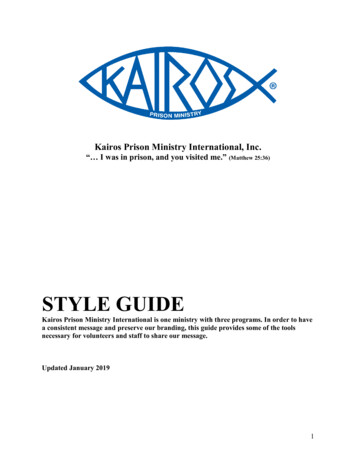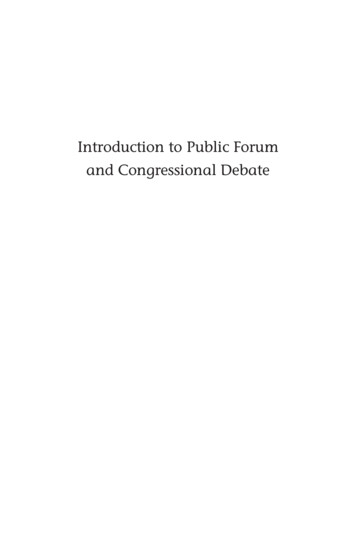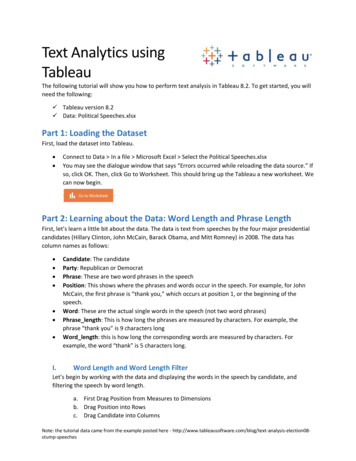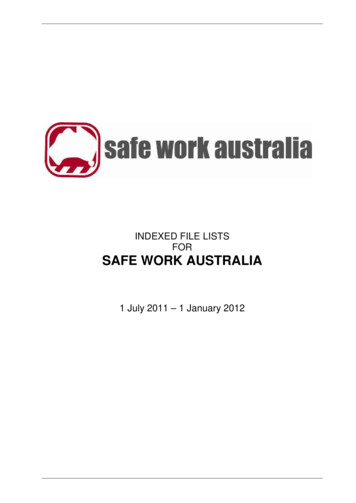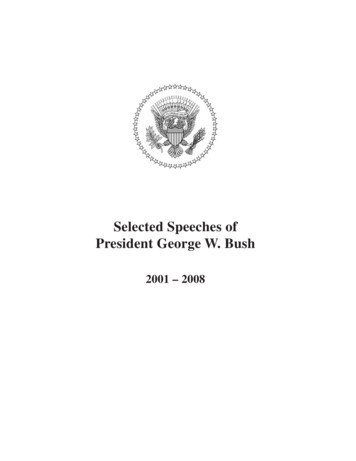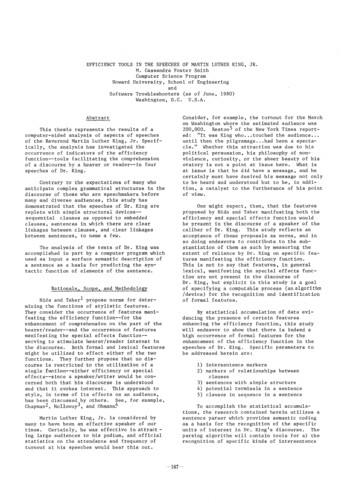
Transcription
EFFICIENCYTOOLS IN THE SPEECHES OF MARTIN LUTHER KING, JR.M. Cassandra Foster SmithComputer Science ProgramHoward University, School of EngineeringandSoftware Troubleshooters (as of June, 1980)Washington, D.C.U.S.A.Consider, for example, the turnout for the Marchon Washington where the estimated audience was200,000.Reston 5 of the New York Times reported:"It was King who.touched the audience.until then the pilgramage.had been a spectacle." Whether this attraction was due to hispolitical persuasion, his philosophy of nonviolence, curiosity, or the sheer beauty of h i soratory is not a point at issue here.What isat issue is that he did have a message, and hecertainly must have desired his message not onlyto be heard and understood but to be, in addition, a catalyst to the furtherance of his pointof view.AbstractThis thesis represents the results of acomputer-aided analysis of aspects of speechesof the Reverend Martin Luther King, Jr. Specifically, the analysis has investigated theoccurrence of indicators of the efficiencyfunction--tools facilitating the comprehensionof a discourse by a hearer or reader--in fourspeeches of Dr. King.Contrary to the expectations of many whoanticipate complex grammatical structures in thediscourse of those who are speechmakers beforemany and diverse audiences, this study hasdemonstrated that the speeches of Dr. King arereplete with simple structural devices-sequential clauses as opposed to embeddedclauses, sentences in which there are clearlinkages between clauses, and clear linkagesbetween sentences, to name a few.One might expect, then, that the featuresproposed by Nida and Taber manifesting both theefficiency and special effects function wouldbe present in the discourse of a speaker of thecaliber of Dr. King.This study reflects anacceptance of these proposals as norms, and inso doing endeavors to contribute to the substantiation of them as such by measuring theextent of reliance by Dr. King on specific features manifesting the efficiency function.This is not to say that features, in generallexical, manifesting the special effects function are not present in the discourse ofDr. King, but explicit in this study is a goalof specifying a computable process (an algorithm/device) for the recognition and identificationof formal features.The analysis of the texts of Dr. King wasaccomplished in part by a computer program whichused as input a surface semantic description ofa sentence as a basis for predicting the syntactic function of elements of the sentence.RationalesScope, .and MethodologyNida and Taber I propose norms for determining the functions of stylistic features.They consider the occurrence of features manifesting the efficiency function--for theenhancement of comprehension on the part of thehearer/reader--and the occurrence of featuresmanifesting the special effects function-serving to stimulate hearer/reader interest inthe discourse.Both formal and lexical featuresmight be utilized to effect either of the twofunctions.They further propose that no discourse is restricted to the utilization of asingle funtion--either efficiency or specialeffects--since a speaker/writer would be concerned both that his discourse is understoodand that it evokes interest.This approach tostyle, in terms of its effects on an audience,has been discussed by others.See, for example,Chapman 2, Helloway 3, and Ohmann By statistical accumulation of data evidencing the presence of certain featuresenhancing the efficiency function, this studywill endeavor to show that there is indeed ahigh occurrence of formal features for theenhancement of the efficiency function in thespeeches of Dr. King.Specific parameters tobe addressed herein are:i) intersentence markers2) markers of relationships betweenclauses3) sentences with simple structure4) potential terminals in a sentence5) clauses in sequence in a sentenceTo accomplish the statistical accumulations, the research contained herein utilizes asentence parser which provides semantic codingas a basis for the recognition of the specificunits of interest in Dr. King's discourse.Theparsing algorithm will contain tools for a) therecognition of specific kinds of intersentenceMartin Luther King, Jr. is considered bymany to have been an effective speaker of ourtimes.Certainly, he was effective in attracting large audiences to his podium, and officialstatistics on the attendance and frequency ofturnout at his speeches would bear this out.-167--
markers; b) the recognition of markers betweensentences; c) the recognition of simple sentences; d) the recognition of potential terminals in a sentence; and e) the recognition ofsequential vs. embedded clauses in a sentence.m a y wish to feel free to use the simplest grammatical model that satisfies the requirementsof his particular job. ''II Further, it isanticipated that the algorithm used in thisstudy in identifying the regular recurringstructural patterns (the analogies) in thespeeches of Dr. King will also identify theanomalies by the rejection of them as analogies.Clearly, an investigation into the frequency of occurrence of a limited set ofstylistic features in the oratory of a singleperson will not permit definitive conclusionson the universal set of features present in alloratory.Nor will it define an algorithm (ordevice) for the consistent recognition of suchfeatures. "But it is anticipated that theseresults will serve as substantiation of proposednorms (as mentioned above) and as a cue to boththe minimal information necessitated in theprocessing of natural language as well as a cueto a methodology for the recognition of formalstylistic features.Given the above considerations concerningthe rationale and methodology for the study andthe delimiting of the scope, the following section will discuss the specific speeches ofDr. King comprising the corpus for the study.The CorpusFour speeches have been selected to comprise the corpus for the study.Text I ispopularly known as I had a Dream. 12 Text II isthe Nobel Prize Acceptance Speech. 13 Text IIIis the text of Dr. King's statement on the eveof his death, 14 and Text IV is a sermon delivered by Dr. King at his home church in Atlanta,Georgia. 15The appropriateness of an examination oflimited stylistic features, however, has beensanctioned by many stylists.Hough 6 states:"The choice of this word rather than that, ofthis kind of syntactical construction ratherthan another, is a visible fact, whose natureand effects can be examined."He furtherelaborates:"Study a particular stylisticdevice as it is employed in an individual workof art . We are inquiring how a specificconfiguration is used for a special.purpose ."The texts cited above were selected asrepresentative of the gamut of the speech typesdelivered by Dr. King based on the makeup ofthe audiences which were present.Text I wasdelivered to general audience composed of oldand young, black and white, rich and poor,educated and uneducated.Text II was deliveredto a more elite audience, probably all highlyeducated and distinguished in their fields--theNobel Prize Committee.The third text represents an impromptu speech delivered by Dr. Kingon the eve of his death.The final text wasdelivered by Dr. King to his usual audience-his flock at his home church.Ullman 7 is also encouraging:"This is theway stylistic analysis proceeds:It takes aparticular device in a language or in a limitedcorpus and examines the different effects whichemanate from it.But one could also reversethe process and investigate, for example, thevarious devices through which irony is expressedin the language or corpus."Text I contains 81 sentences, 1,644 words,and 156 clauses.The mean (simple average)words per sentence is 20.2, and the mean clausesper sentence is 1.9.Text II contains 43 sentences with a total of 1,156 words and 122clauses.Here, the mean sentence length is26.91 words, and the mean number of clauses persentence is 2.7. Text III consists of 23 sentences, 34 clauses, and 256 words.The meannumber of words per sentence is 11.13, and themean number of clauses per sentence is 1.48.Text IV contains 136 sentences, 2,316 words,and 250 clauses.The mean sentence length is17.05 words.The mean number of clauses persentence is 1.8.It is further anticipated that many linguists will insist that a speaker such asDr. King will have demonstrated a wide varietyof structural tools in his oratory.This studyproposes to show evidence, as has Ohmann 8 in hisanalyses of Faulkner, et al, substantiatingMilic 9 that "the language of an individual isrestricted.though.able to interpret the fullrange of syntactic patterns.the languageaffords, for some reason he seems to depend forhis expressive needs on merely a selection fromthe available total."Further discussion of theexpectation of restricted use of language toolscan be found in Chapman 2 and Ohmann. 0Since it is expected that the structuralpatterns present in Dr. King's oratory are verylimited in number and recurring, one anticipatesthat a parsing algorithm for the recognition ofthese structural units will be simple.A parserbased on a transformational model, for example,would contain many "complications.irrelevantto the particular problem.the student of styleCombining the data from the four texts,the corpus consists of 283 sentences, 562clauses, 5,391 words.The mean sentence lengthfor the corpus is 18.971, and the mean numberof clauses per sentence is 1.982.The standarddeviation of the sentence lengths is 12.96words.The standard deviation of the clauses168
permeantheforText Analysissentence is 1.32.Table i summarizes thesentence lengths in words by text and forcorpus.Table 2 contains comparable dataclauses per sentence.In this section the grammar and the algorithm for the analysis of the texts comprisingthe corpus are presented.As stated earlierthe goals of the analysis are:a) the recognition and identification of explicit semanticsyntactic markers between sentences, b) therecognition and identification of explicitsemantic-syntactic markers indicating relationships between clauses, c) the recognition andidentification of sentences with simple structures, d) the recognition and identification ofpotential terminal points in a sentence, ande) the recognition of sequential versus embeddedclauses in a sentence.These statistics have been obtained by amanual tallying of the sentences, clauses, andwords in the texts and as such areTABLE iMEAN WORDS PER SENTENCE BY TEXT AND 11.1317.0218.97The GrammarThe grammar underlying the parsing algorithm is presented below.It is defined as anordered 4-tuple: V,V ,SC,'S' where V is thevocabulary of terminal symbols (or words fromsentences or items from the lexicon); V" is thevocabulary of nonterminal symbols (the semanticcodes, etc.); SC is a set of semantic compatibility rules; and "S" is an initial string orsentence.The semantic compatibility rulesare presented below as a numbered set of rulesin Backus-Naur Form to more efficiently indicate alternative reductions.TABLE 2MEAN CLAUSES PER SENTENCE BY TEXT AND nceIn Backus-Naur (or Backus-Normal) Form(BNF) alternative reductions for an elementof V or V" are specified in one rule.Thisis in contrast to the method used generallyby linguists in specifying a separate rulefor each alternative.For example, many linguistic systems would specify rule 1 as:1.932.791.481.841.99E EEE EAEE E-lexemeE EV O E.preliminary and for the purpose of demonstrating the volume of information under study.Further, the tables presented here are for thepurpose of describing the raw data worked within this research.Further sections containdiscussions of the data with respect to theparameters under investigation and the significance of them to the style of Martin LutherKing, Jr.A fuller study of the research discussed herein may be found in Smith 16 from whichthis study was extracted.In the notation utilized here nonterminal symbols are enclosed in angular brackets ( ),and the alternatives are separated by verticalbars ( I )"The Semantic CompatibilityThe reader should be forewarned that thispaper is intended to be read by linguists.Itis assumed that the reader is knowledgeable ofpast and present trends in the branches oflinguistics.Readers who are uninitiated inthe field might consider Dinneen 17 which isfairly objective in its treatment of the trendsin linguistics from ancient times to the mid1960's.Rulesi. E : E E EV 0 E 2. S : K I K RCUTS S 3.I E At E I E-lexeme 1I RCUTS S 1RCUTS: YTIMEI,I- I " I ' I ANDIORI :4.169- K : E I X E X I X E I E X
5. X : 0 6. A : A A 7. O : 0 0 A 0 RHM O I O-lexeme8. RHT : RHT 0 I RHT RHT P M RHT I RHT-lexeme9.] A I RHT The clause (or kernel sentence or configuration) discussed herein is strictly a surfacestructure unit in which a finite verb formoccurs with or without its subject or objectnoun-phrase.That is to say, a configurationwith one or more deleted noun-phrases but witha finite verb form is considered a clause.I A RHM A I A-lexemeI] O A I 0 I RHT This type of analysis, then, in terms ofthe surface structure alone is considered bysome to be a current trend.J. D. Fodor 23 forexample, states:"The move has been from theinterpretation of deep structures alone (as inKatz's theory) via the interpretation of deepand surface structures (as in Jackendoff'stheory) to the interpretation of surface structures alone."For a contrary view one isreferred to Woods. 24 RHM : ANDIORIBUTINORINEITHERIEITHER IIn the above rules E-lexeme, O-lexeme,A-lexeme, etc., refer to a word from the lexiconbelonging to the semantic domain indicated.RCUTS represents a subset of relators (R).The grammar described above is based on alinguistic statement developed by Dr. MichaelZarechnak 18 for the analysis of weather reportdata.The approach discussed here representsan expansion and extension of the approach tomore general literature.The author providedthe computational approach and methodology forthe weather report analysis.Using Kholodovich's 19 theory of subsets it was determinedthat the weather report sentences could berepresented in a limited number of frames.(See Smith20, 21 for a summary.)In the treatment of the sentences as string formulae thisgrammar is also influenced by the work ofZellig Harris. 22Statistical Measuresof StyleIn the analysis of selected texts thisstudy has accumulated statistics on certainfeatures proposed as manifestations of theefficiency function in the discourse of MartinLuther King, Jr.These specific features werechosen following the dictum of stylists such asChatman: 25 "we count features only to demonstrate that they are distinctive enough to benoticed without recourse to statistics; thecount is significant only insofar as it corresponds to a preformed impression in the sensitive reader's mind."The study contained hereinmay well exemplify what Enkvist 12 alluded to inthe following:"It is the task of LinguisticStylistics or Stylolinguistics to set up inventories and descriptions of stylistic stimuliwith the aid of linguistic concepts."With respect to the goals listed at thebeginning of this section, the analyzer (parser)described above accomplishes the identificationof explicit markers between clauses, and rejectsthose sentences in which there are no explicitmarkers between pairs of clauses.Via therecognition of sequential clause boundaries,it also indicates potential terminal pointsin a sentence and the number of clauses persentence.Since the kernelization algorithmrelies on explicit markers between sequentialclauses to effect kernelization and rejectssentences with embedded clauses, it indicatessequential vs. embedded clauses.In flaggingsentences with introductory relators, theanalyzer has also accomplished a portion of theidentification of explicit markers betweensentences.The Style of Martin Luther. King, Jr.Ullman 7 discussed two general approachesto stylistic studies.In the first of thesethe stylist begins with a stylistic device andanalyzes a corpus for effects from the device.In the second approach the stylist begins withan effect and analyzes a corpus for deviceswhich have contributed to the effect.Thisapproach might be graphically depicted asfollows:Some final observations should be addedat this point concerning the goals and motivation for the analyzer described above.Theanalysis is accomplished by the analysis ofword-level semantic units to obtain informationon the surface sentence structure.No deepsemantic structure analysis (ala generativesemantics) summoning, for example, hypotheticalunderlying propositions or deep syntactic structure analysis (ala transformational theory)providing, for example, proposed kernel structures underlying verbal (infinitive, gerundive,participial) phrases is included.effect aevice de e e- --170% 4eo
Further, with respect to the third device-sequential clauses--141 sentences (49.82% of thecorpus) are composed of clauses in sequencewhile i0 sentences (3.53% of the corpus) containembedded clauses.Thus with respect to markedversus unmarked clause boundaries and sequentialversus embedded clauses, 127 sentences (44.88%of the corpus) contain clauses in which theinterclause boundaries are marked and in whichthe clauses are in sequence.Twenty-four sentences (8.48% of the corpus) contain sentencesin which the interclause boundaries are unmarkedor in which embedded clauses are present.Further, none of the sentences with unmarked clauseboundaries contains embedded clauses, and noneof the sentences containing embedded clauseshas unmarked interclause boundaries.The approach taken in this stylistic studyof the oratory of Martin Luther King, Jr. mightbe considered analogous to the second approachabove.Its graphic depiction is as follows: c efficiency o .9 sequential clauses oeeIn considering the fourth device--simplesentences--this study has shown that 132 sentences (46.64% of the corpus) are simple withrespect to the number of clauses (one) per sentence.Further, since clauses in sequence areless complex and easier for the listener todecode, one may consider the 127 sentences withclauses in sequence and marked interclauseboundaries simple also.Thus, 259 sentences(91.52% of the corpus) are simple.such that the effect proposed is the efficiencyfunction (facilitating understanding on thepart of the hearer/listener), and the devicesunder inspection in the analysis are a) intersentence markers, b) markers of relationshipsbetween clauses, e) sequential clauses, d) simple sentences, and e) potential terminal points.Finally, with respect to potential terminalpoints in a sentence, one can see that clausesin sequence provide potential terminal points.Thus, the 141 multiclause sentences whichcontain clauses in sequence are evidence of thepotential of terminal points in addition tothe point at the end of the sentence.With respect to intersentence markers ithas been shown that all of the texts arestrongly linked by repetition, anaphora, andintroductory relators.An inspection of thetexts shows that there is indeed a preponderance of sentence to sentence links plus linksjoining early parts of the texts to latterportions.The text coherence is accomplishedin part in text I by repetitions such as "Ihave a dream", "Let freedom ring.", etc.Intext II, one can observe the various repetitionsand references to "I accept the Nobel Prize forPeace", "this award", "this prize", "I accept",etc. Text III is less linked by anaphora andrepetition than the other three texts. Dr. Kingrelies more on introductory relators with 56.52%of the sentences in this impromptutext delivered on the eve of his death containing introductory relators.Text IV is linked by repetition and references such as "It's midnight.","the bread of hope", "the bread of faith", "thebread of love." Clearly, therefore, thisdevice is heavily present in Dr. King's oratory.Clearly, from the above one can see thatthe five devices proposed as contributors tothe efficiency effect are present in high proportion in the oratory of Martin Luther King,Jr.This study has shown that, consciously ornot, Dr. King has structured his oratory suchthat there is a preponderance of tools whichaid the hearer/reader in the comprehension ofthe text.One might conclude by agreeing withNichols 26 who quotes Aristotle as having saidthat to know what to say is not enough, butone must also know how it must be said.Shesummarizes by stating that, indeed, the effectiveness of Adlai Stevenson, John F. Kennedyand, Martin Luther King is in part due to the"uniqueness of their handling of the languagepatterns."General ConclusionsThe second device indicative of the efficiency effect under analysis in the texts isthe presence of markers between clauses.Inthe four texts 151 of the 283 sentences aremulti-clausal.Of these 137 (48.41%) containexplicit markers between clauses.Fourteen ofthese (4.95% of the corpus) contain clauses inwhich the boundaries between are unmarked.As was stated in the introduction, thisstudy does not purport to capture the totalstyle of Martin Luther King, Jr.It hasendeavored to show evidence of specific structural (and lexical to a very small extent)devices which enhance the efficiency function.Anyone inspecting these texts of Dr. King's171
may observe that there is a wealth of bothstructural and lexical tools which might provideinspiration to further study of the oratory ofDr. King.With respect to structural analysis, onemight consider the role of infinitive phrases,gerunds, and participles in Dr. King's texts.One might also be interested in analyzing theclause construction of his sentences with respect to modifiers, the presence or absence ofthe subject and object, etc.There are also indications of studies whichmight approach an analysis of Dr. King's styleon the lexical level. One observes many instances, especially in "I Had a Dream ''12 ofmetaphor , simile, collocative clash (unusualcombinations), and dated and outmoded words.These are just a few of many indications offurther direction in the study of the styleof Dr. Martin Luther King, Jr.This research was supported in part by theFaculty Research Program in the Social Sciences,Humanities, and Education, Office of the VicePresident for Academic Affairs, Howard University, Washington, D.C.ReferencesI.2.3.Nida, Eugene A. and Taber, C. R. Com onential Analxsis of Meaning. Mouton, TheHague, 1974.Chapman, Raymond. Linguistics and Literature! An Introduction to LiteraryStylistics. T.&A. Constable, Edinburgh,1973.Holloway, John. Matthew Arnold. The Victorian Sage: Studies in Argument. ArchonBooks, Hamden, N.J., 1962. Reprintedition, Babb, Howard S. (Ed.). Essa fsin Stylistic Analysis. Harcourt Brace,Jovanovich, 1972, 293-320.8.Ohmann, Richard M. Generative grammars andthe concept of literary style. Word20, 1964, 423-39.9.Milic, Louis. Introductory essay. Stylistson Styli . Milic, Louis T. (Ed.).Charles Scribener's Sons, New York1969, 1-24.i0.Ohmann, Richard M. Prolegomena to theanalysis of prose style. Style inProse Fiction. Martin, H. (Ed.).Columbia University Press, New York,1959. Reprint Edition, Babb, Howard S.(Ed.). Essays in Stylistic Analysis.Harcourt Brace, Jovanovich, New York,1972, 36-49.ii.Enkvist, Nils E. LinguisticS l i s t i c s .Mouton, The Hague, 1973.12.King, Martin Luther, Jr. Text of speechdelivered at Lincoln Memorial,Washington, D.C.: I had a dream.August 28, 1963.13.King, Martin Luther, Jr. Nobel Prizeacceptance speech at Oslo, Norway.December i0, 1964.14.King, Martin Luther, Jr. Text of Dr. King'sstatement on the eve of his death.April 3, 1968.]5.King, Martin Luther, Jr. Message to theworld: It's midnite. (Date unknown).16.Smith, M. Cassandra. The Grammatical Structure of Oratory. University MicrofilmsInternational, Ann Arbor 1980 (Forthcoming). (1979 Ph.D. Dissertation,Georgetown University, Washington,D.C.)17.Dinneen, Francis P. An Introduction toGeneral Linguistics. Holt, Rinehartand Winston, New York, 1967.4.Ohmann, Richard M. Literature as sentences.E s s a s i n Stylistic Anal sis. Babb,Howard S. (Ed.) Harcourt Brace,Jovanovich, 1972, 353-64,18.Zarechnak, Michael and Coyne, E. Semanticanalysis of natural language statements. Linguistics 182. Mouton, TheHague, 1976.5.Reston, James. The March on Washington.New York Times. August 29, 1963.19.Kholodovich, A. A. Theory of word subclasses. Voprosyjazykoznanija i. 1960,32-43,6.Hough, Graham. Stxle and Stylistics. Humanities Press, New York, 1969.20.Smith, M. Cassandra. Status of a tutorialreading course and data gathering forsemantic input for a syntactic analysis. 1977. (Course paper GeorgetownUniversity, Washington, D.C.)7.Ullman, Stephen. Two approaches to style.Patterns of Lit erar XStyle. Strelka,Joseph (Ed.). The Pennsylvania StateUniversity Press, University Park,1971.172
21.Smith, M. CassaNdra. Kernel sentence analysis based on the theory of subclasses.1978. (Course paper Georgetown University, Washington, D.C.)22.Harris, Zellig S. String Analysis of Sentence Structure. Mouton, The Hague,1962, 29-42.23.Fodor, Janet Dean. Semantics: Theories ofMeaning in Generative Grammar. ThomasY. Cromwell, New York, 1977.24.Woods, William A. What's in a link: foundations for semantic networks. Representation and Understanding. Bobrow,Daniel and Collins, Allan (Eds.).Academic Press, New York, 1975, 35-82.25.Chatman, Seymour. Linguistics, poetics andinterpretation: the phonemic dimension.The Quarterly Journal of Speech XLIII.1957.26.Nichols, Marie H. Rhetoric and style.Patterns of Literar Style. Strelka,Joseph, (Ed.) Pennsylvania StateUniversity Press, University Park,1973, 130-43.173
Dr. King comprising the corpus for the study. The Corpus Four speeches have been selected to com- prise the corpus for the study. Text I is popularly known as I had a Dream. 12 Text II is the Nobel Prize Acceptance Speech. 13 Text III is the text of Dr. King's statement on the eve


